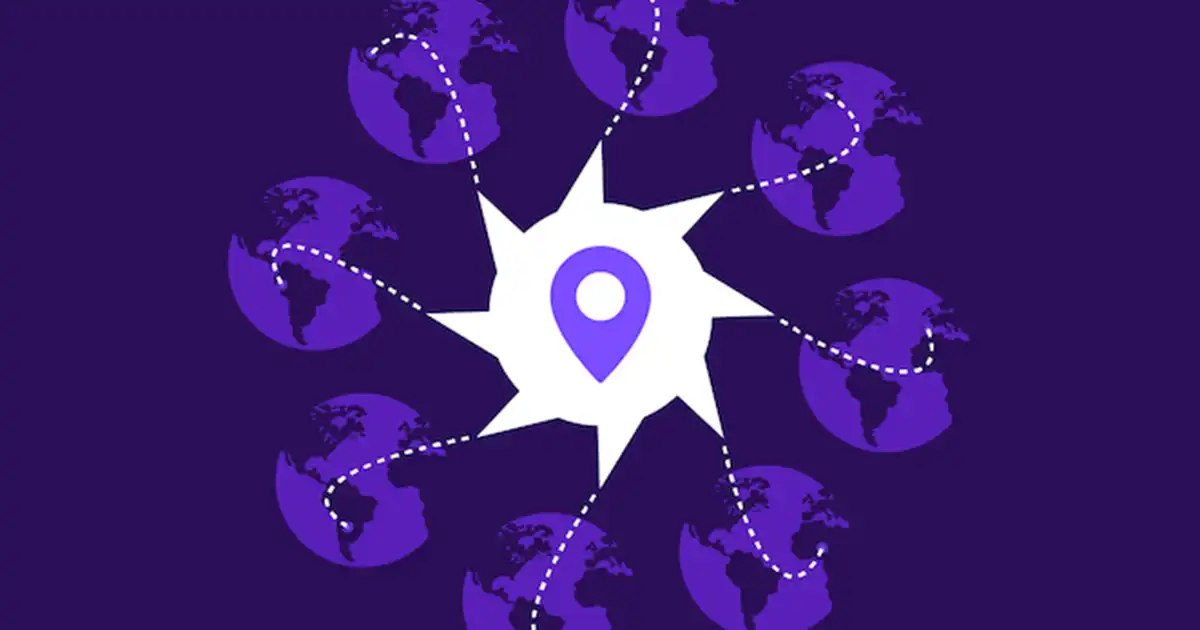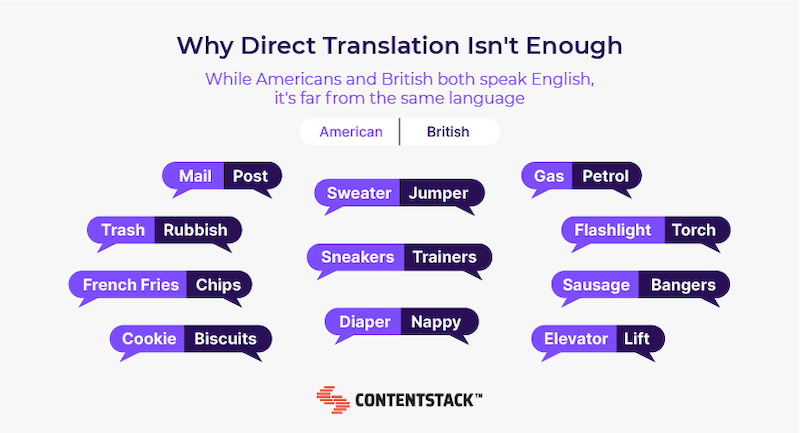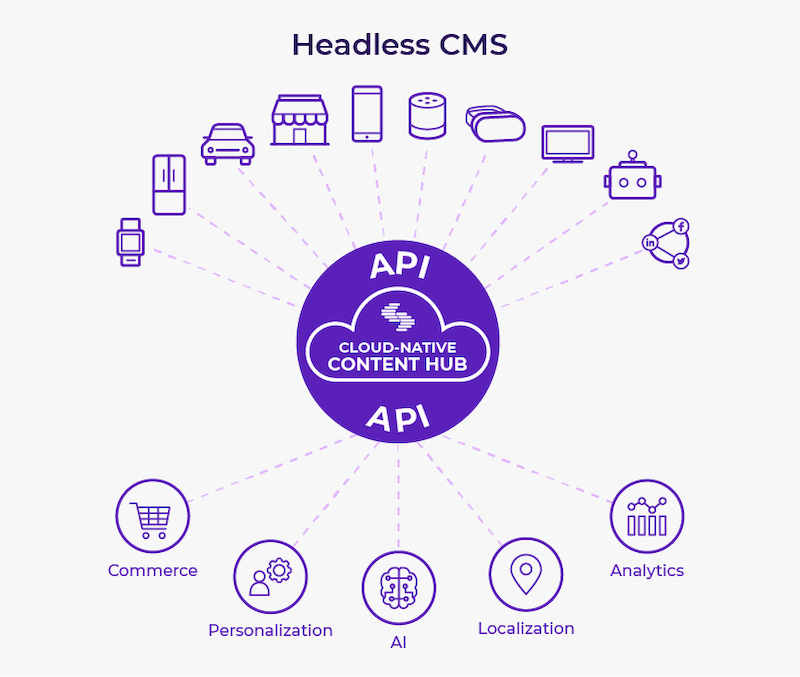Localization strategy: building a scalable, global content operation

To take your business global, you must ensure the customer experience stays local. In other words, for your business to build a scalable, international content operation, you need a strong localization strategy.
To reap the benefits associated with localization (which we'll describe later), organizations must develop a strategy that starts with best practices and incorporates cutting-edge technology into their content stack to pull off flawless localization across any sub-brand or country.
By the end of this guide, you will be well-versed in the nuances of localization, the benefits that make an excellent localization strategy, and exactly what steps and tech it takes to create such a strategy within your organization.
What is localization?
A simple definition of localization is making something (content, in this case) local. Although it does include translation, localization is much more than that.
Translation is changing words from one language to another. But localization goes beyond just converting written language to account for syntax, phrasing, graphics, colors, layouts, and more. This comprehensive approach is designed to ensure the content aligns with the particular audience with which a business is trying to connect.
For instance, an American company opening an office in China would need to at least translate its English resources into Mandarin, the most common dialect of Chinese. But with an intelligent localization strategy, they would continue. Localization would require the company to learn more about the region where they were expanding to adopt the local dialect and tap into current events, everyday phrases, and other cultural nuances.
|
Translation
|
Localization
|
|
| Updates Content |  |
 |
| Updates Graphics |  |
 |
| Considers Context |  |
 |
Why is it essential to have a localization strategy, and what are the benefits?
An effective localization strategy allows you to take a unique marketing approach — one that has plenty of business benefits.
Improve organic search results in every foreign market
Localization can increase your chances of showing up when a consumer uses a search engine to research the product or service you offer. Unsurprisingly, most consumers prefer to shop in their language.
When was the last time you purchased something online from a brand you didn't recognize using a language you can't read? Consumers aren't going to play a guessing game with poorly translated or foreign content if there's another option in their local language.
When your content is not only optimized for the local language but for the unique dialects, phrases, and even slang terms used in that location, it's more likely to match up with the search terms your target audience naturally uses.

Enhanced user experience for global sales through localization strategy
Localization is more than just translated content. It's about crafting a personal and culturally relevant user experience. Incorporating culturally relevant content is a proven way to improve user engagement. By understanding different cultures, organizations can create engaging content that truly speaks to the audience.
Moreover, personalized experiences have a direct impact on customer satisfaction. A localization strategy helps businesses to customize their offerings, making customers feel valued and understood. This level of personalization enhances the user experience, leading to higher engagement rates and increased sales.
Building brand loyalty with localization
Localization also contributes significantly to building brand loyalty. By establishing trust through language and cultural sensitivity, businesses can foster positive brand perception. This respect for local cultures and languages shows customers that a company values their unique identities, which can strengthen customer loyalty.
Another aspect of building brand loyalty involves fostering long-term customer relationships through customization. Customized experiences show customers that a business understands and caters to their needs, further enhancing customer loyalty.
Global brand consistency: maintaining a unified brand image across cultures
A significant advantage of a localization strategy is that it helps maintain global brand consistency. When a business creates localized content, it ensures that its brand image remains unified across different cultures. This consistency strengthens overall brand perception.
For instance, if your brand uses social media as a localization strategy, you can communicate a consistent message to all local markets. This not only enhances the user experience but also improves customer engagement.
Provide better customer support while watching costs
In an age where more people are tech-savvy than ever before, the majority of consumers want to solve their customer service issues without speaking to an agent whenever possible. That means you could save your customer support agents time — and money — by simply making it easier for customers in every locale to find, read, and use the resources they need to help themselves answer common questions.
Localization strategy expands market reach
A robust localization strategy is crucial in accessing diverse global demographics. By creating targeted content for local markets, businesses can connect with audiences they might otherwise overlook. This approach not only expands market reach but also opens new avenues for business expansion and revenue growth.
Furthermore, a global content operation powered by a solid localization team can help businesses scale their efforts efficiently. This scalability can lead to improved ROI, making localization a cost-effective strategy.
Localized competitor analysis and strategic positioning
Implementing a localization strategy provides a competitive advantage. It allows a business to conduct a localized competitor analysis and strategically position itself in the market. A localization team can identify unique selling propositions within local markets and devise marketing strategies accordingly.
A few considerations: challenges, technical and operational hurdles in localization
Here are a few essential things to consider when implementing a comprehensive localization strategy.
Technological and operational challenges
One of the primary disadvantages associated with localization is the technical and operational challenges that come with it. These implementation challenges can range from language translation difficulties to understanding cultural variations, and to overcome these issues, businesses need to invest in a competent localization team and robust technology.
- Budget constraints in comprehensive localization efforts
Localization efforts can be expensive. Budget constraints can limit how much a business can implement its localization strategies, including the cost considerations related to hiring a localization team, translating content, and adapting marketing strategies to local markets.
- Risk mitigation
Another disadvantage is the need for risk mitigation. Expanding into new markets involves risk, and a global content operation is no exception. Businesses must devise risk mitigation strategies to overcome potential pitfalls in international expansion.
While a localization strategy has challenges, its benefits often outweigh the disadvantages. It enhances market reach, ensures brand consistency, and provides a competitive edge, making it an essential component of any successful global expansion effort. However, careful planning, including addressing implementation challenges and cost considerations, is crucial for a successful localization effort.
7-step localization strategy for building a scalable content program
We'll be honest: getting a large-scale localization operation off the ground isn't a walk in the park. However, in today's global economy, it's one of the more effective, affordable, and achievable methods for outpacing competitors and delivering loyalty-earning experiences to consumers. That's why, in this section, we've broken out every single important step in building the localization strategy that will help you support and accelerate your business growth.
-
Choose locales to target
As we mentioned, when done right, localization will require you to expend some time and resources. The first thing you should do is decide where it's best to use that time and those resources.
There are plenty of ways you can narrow down the locales you want to target as you take your first stab at building out a scalable content program. First up, think about any new markets your business is expanding into in the next few years. We recommend checking out your sales and marketing data for areas you've already moved into and need to improve. Those are a perfect target.
Keep the number of locales manageable the first time you work through this strategy. Ideally, the work you do now will help create a smoother process, so remember, you can always add new locations later as your business grows and changes.
-
Choose which platforms to localize
How do most consumers interact with your brand in each locale you've chosen to target? In France, most transactions may occur on a desktop, while in Nigeria, most of your users may be mobile-first. You'll want to compile this data to save time and money by focusing on the channels your consumers love most.
If you're growing into a new area, see which platforms your competitors are most active on to help narrow down the marketing channels you'll localize.
-
Define the content, graphics, and products to be localized
After choosing your markets and platforms, it's time to take the final step in narrowing your focus: Identifying the actual pieces of content that you will localize. In this stage, your content team will be thinking about things like:
- Do we need to change the language of our social ads?
- Does the app color and layout need to be updated?
- Will we have to rename products?
- What about pricing?
Defining your content assets is a critical step in the process. If you haven't already, this is when you want to spend plenty of time reviewing and organizing your content resources, as well as developing a system for upgrading key content pieces.
-
Conduct market research for each locale
This step may happen with the one above because even if you're confident that something needs to be localized, you may need to know what changes must be made.
This could mean hiring localization professionals to review the content elements you want to update closely. They can help ensure that your edits align not just with the regional language but with all the nuanced cultural markers that make your brand feel like a community member.
-
Identify dependencies
One of the most time-consuming parts of building a scalable, global anything is working through the many dependencies. Marketing messaging that's reused across several social campaigns will need to be consistent.
Updating product descriptions or prices could require approvals from different teams. Whenever you make updates or changes, it's vital to think through the hurdles you'll have to clear as you go.
Dependencies are just a reality regarding refreshing processes and resources within your business. Before laying down any due dates, you should take some time to identify as many of these dependencies as possible so that the time it takes to work through them is accounted for in the next phase.
-
Set up owners, milestones, objectives, and a timeline
Start setting goals for its completion, including assigning owners for each task, setting up milestones to mark when you expect critical studies to be complete, defining the objectives each task should help you achieve, and developing an overarching timeline for your entire localization effort.
Taking these steps doesn't just motivate you to move through the necessary tasks, but it is also an excellent resource when you have to provide progress reports for stakeholders.
-
Implement flexible content management technology
Finally, it's time to implement the technology that makes scalable, global-reaching content localization possible. It all starts with an upgrade to a headless content management system (CMS).
Headless CMS is a modern content management platform built with modular architecture. Its structure separates the back end (the "body") of the CMS, where content is created and managed, from the presentation layer (the "head"), where content is distributed to a website page or a mobile app screen.
Application programming interface (API) technology creates a flexible framework in which all the elements of a CMS can work together despite being decoupled, and the best-of-breed tools — such as translation and localization solutions — can be integrated into your headless CMS. This integration allows your content team to flawlessly build localized content campaigns at any point in the content creation workflow.

Thanks to its MACH architecture, headless CMS enables businesses to rapidly take advantage of cutting-edge strategies such as localization and scale content operations rapidly. MACH describes technology that employs Microservices, uses API connectivity, is Cloud-native, and whose platform is Headless.
Thanks to its MACH architecture, a headless CMS like Contentstack enables businesses to take advantage of cutting-edge strategies such as localization and to scale content operations rapidly. MACH describes technology that employs Microservices, uses API connectivity, is Cloud-native, and whose platform is headless.
Successful implementation of localization strategy with headless CMS
Now that you know what a localization strategy is and how many benefits it can bring to grow your business, let's look at a few real-world examples.
Successful localization in the flight industry
Airlines understand the importance of a strong localization strategy to enhance user experience and foster customer loyalty. For instance, when Icelandair needed to design, develop, and launch a new website that could support their modular approach to content design, they chose Contentstack.
After years of VYRE and dotCMS and frustrations ranging from long publishing times to a lack of connectivity with applications, Icelandair needed a solution — they needed a headless CMS platform. Now, they are successfully creating localized content to appeal to target markets and delivering translated content 70% faster. They can also ensure that translated content resonates with local customs and dialects, significantly improving brand perception and cultural relevance in the regions they serve. Read the case study to find out more about why Icelandair chose Contentstack.
Effective localization strategy in electronics manufacturing
Mitsubishi Electric, a global leader in electronics and electrical equipment manufacturing, found success in headless CMS when they needed to migrate from a legacy system and now use it across 21 EMEA sites. They now wield the ability to better connect with local sales offices and can empower local sales leaders with the ability to create content.
According to Andrea Intveen, website manager of Mitsubishi Electric Factory Automation EMEA, "This has begun to pay dividends as we now see much more content from local teams that resonates with their markets." Check out the success story to see how they increased their market reach and enhanced customer engagement across various regions.
Fitness industry localization triumph
The fitness industry is yet another sector where localization strategies have proven effective. Freeletics, an AI-based fitness and lifestyle coaching app, is one of the fastest-growing sports and lifestyle companies in the world. With 48 million users and an audience across 160 countries, they needed a CMS platform that would allow them to scale localized content fast.
Creating localized content that resonates with their target demographic's lifestyle and fitness goals has improved customer loyalty and resulted in impressive scalability in their global content operation. Watch the video on how Freeletics used Contentstack to increase content delivery speed by 80% and speed up translation for their many locales.
Learn more
Unlock your localization strategy with a suitable headless CMS. To understand how achievable large-scale localization can be with an easy-to-use headless CMS, check out some of our other content:
- Contentstack introduces advanced language and localization features
- Update and publish localized content with ease
To learn even more about developing a localization strategy and building a scalable content program, read:
- Localization and personalization at scale
- How content localization can benefit your company in a global market
To see how Contenstack can help your organization, schedule a free demo today.
About Contentstack
The Contentstack team comprises highly skilled professionals specializing in product marketing, customer acquisition and retention, and digital marketing strategy. With extensive experience holding senior positions at renowned technology companies across Fortune 500, mid-size, and start-up sectors, our team offers impactful solutions based on diverse backgrounds and extensive industry knowledge.
Contentstack is on a mission to deliver the world’s best digital experiences through a fusion of cutting-edge content management, customer data, personalization, and AI technology. Iconic brands, such as AirFrance KLM, ASICS, Burberry, Mattel, Mitsubishi, and Walmart, depend on the platform to rise above the noise in today's crowded digital markets and gain their competitive edge.
In January 2025, Contentstack proudly secured its first-ever position as a Visionary in the 2025 Gartner® Magic Quadrant™ for Digital Experience Platforms (DXP). Further solidifying its prominent standing, Contentstack was recognized as a Leader in the Forrester Research, Inc. March 2025 report, “The Forrester Wave™: Content Management Systems (CMS), Q1 2025.” Contentstack was the only pure headless provider named as a Leader in the report, which evaluated 13 top CMS providers on 19 criteria for current offering and strategy.
Follow Contentstack on LinkedIn.




.svg?format=pjpg&auto=webp)
.svg?format=pjpg&auto=webp)
.png?format=pjpg&auto=webp)






.png?format=pjpg&auto=webp)

